Understanding ATS Scoring Algorithms
Learn how ATS scoring algorithms work and optimize your resume to increase your chances of landing an interview.

An Applicant Tracking System (ATS) is software that screens resumes to match job descriptions. Companies use ATS to handle large volumes of applications, automatically filtering resumes based on keyword relevance, formatting, and qualifications. If your resume doesn't align with the job description or ATS requirements, it may never reach a recruiter - even if you're qualified.
Key Takeaways for Optimizing Your Resume
- Keywords Are Critical: Use exact terms from the job description. For example, if "Python programming" is listed, include that specific phrase.
- Keep Formatting Simple: Stick to standard fonts (e.g., Arial, Calibri), avoid graphics or tables, and use clear section headers like "Work Experience" or "Education."
- File Type Matters: Submit your resume as a .docx file for maximum compatibility, though basic PDFs often work too.
- Avoid Keyword Stuffing: ATS systems penalize unnatural repetition of keywords.
- Consistency in Dates and Layouts: Use uniform date formats (e.g., "MM/YYYY") and maintain a clean, single-column structure.
How ATS Works
- Resume Parsing: ATS extracts details like contact info, work history, and skills using Optical Character Recognition (OCR) and Natural Language Processing (NLP).
- Keyword Matching: It checks for job-relevant terms, prioritizing keywords in visible sections like job titles or summaries.
- Scoring & Ranking: Resumes are scored based on keyword relevance, formatting, and alignment with the job description.
Challenges with ATS
- Non-standard resumes with graphics or unconventional layouts may get misread.
- Non-linear career paths or gaps in employment can lower your score.
- Rigid scoring thresholds may filter out qualified candidates.
Tools to Improve Your Resume
- Jobscan: Analyzes keyword gaps but requires manual edits ($49.95/month).
- Rezi: AI-only resume builder for straightforward applications ($29/month).
- TealHQ: Offers tracking and optimization but lacks transparency ($49/month).
- scale.jobs: Combines AI tools and human review, providing real-time updates, proof of submissions, and flat-fee pricing ($9/month for AI; $199 for 250 applications with human assistants).
Quick Comparison
| Feature | scale.jobs | Jobscan | Rezi | TealHQ |
|---|---|---|---|---|
| Free ATS Checker | Yes | Limited scans | No | No |
| Human Review Option | Yes | No | No | No |
| AI Resume Optimization | Yes | Yes | Yes | Yes |
| Pricing | $9/month or flat-fee | $49.95/month | $29/month | $49/month |
| Transparency | Real-time updates, proof of work | None | None | None |
Why It Matters
Understanding ATS scoring ensures your resume isn't filtered out before reaching a recruiter. By tailoring your resume to meet both ATS and recruiter expectations, you increase your chances of landing an interview.
A Guide to Applicant Tracking Systems | Resume Tips | Indeed Career Tips
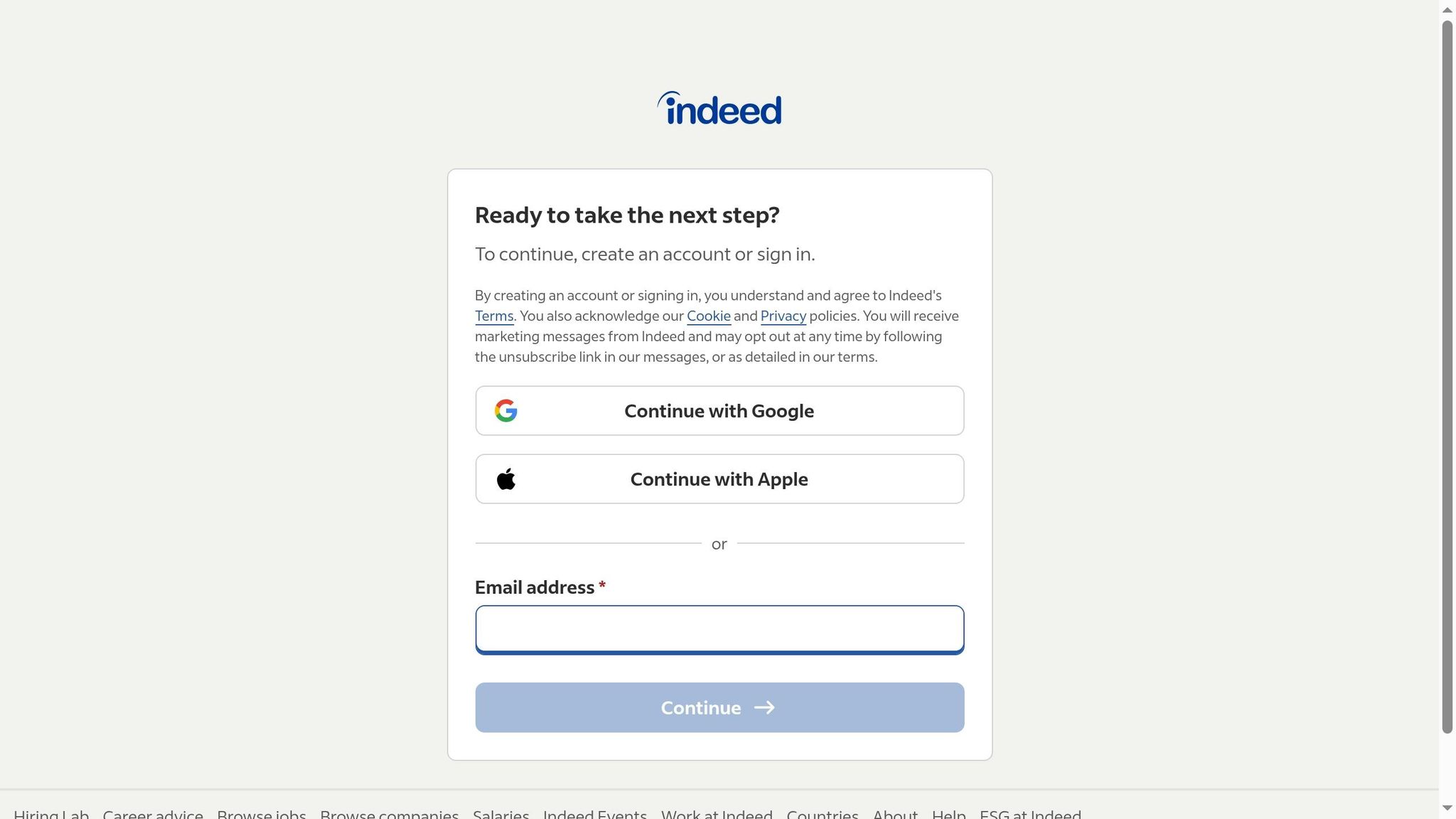
How ATS Scoring Systems Work
Getting a handle on how ATS scoring systems operate can make a big difference when it comes to tailoring your resume for these platforms. These systems follow a step-by-step process, starting with pulling key information from your resume and moving on to evaluating it through keyword analysis and formatting checks.
Resume Parsing and Data Extraction
The first thing an ATS does when you submit your resume is scan and extract the essential details. It looks for common sections like contact information, work experience, education, and skills, relying on familiar headers such as "Experience" or "Education" to organize the data.
Platforms like Workday and Greenhouse use optical character recognition (OCR) to convert your resume into text that machines can read. Then, natural language processing (NLP) steps in to pinpoint critical details like job titles, company names, dates of employment, and educational qualifications. This extracted information is stored in separate database fields for further evaluation.
The accuracy of this process depends heavily on how your resume is formatted. Clean, straightforward layouts with standard headers make it easier for the ATS to correctly interpret your information. On the flip side, resumes with overly complex designs or unconventional formats can confuse the system, leading to missed or misclassified details - which can hurt your score.
While modern ATS systems are better at handling different layouts, they can still struggle with resumes that include graphics, intricate designs, or non-standard section titles. The data extracted here becomes the foundation for all scoring and ranking decisions.
Once the data is in place, the ATS moves on to analyzing your resume for keywords and context.
Keyword Matching and Context Analysis
After parsing your resume, the ATS dives into its keyword analysis. It starts by identifying key skills and terms from the job description and then checks your resume for both exact matches and related phrases.
For example, if a job posting lists "Python programming" as a requirement, the ATS will look for terms like "Python", "Python development", or "Python scripting." The system also evaluates soft skills and experience-related keywords in a similar way. If a job mentions "project management", the ATS will recognize phrases like "managed projects" or "led initiatives" as relevant matches.
Beyond just finding keywords, the ATS assesses keyword density and placement. Keywords that appear in high-visibility areas - like your professional summary or job titles - carry more weight than those buried deep in job descriptions. But don’t overdo it: stuffing your resume with too many keywords can backfire, as ATS systems are designed to spot unnatural repetition.
Geographic and industry-specific terms can also influence your score. For instance, including "New York" or "NYC" on your resume for a role based in the city might give you a slight edge. Similarly, using terms specific to your field shows that you’re familiar with the industry’s language.
This keyword analysis sets the stage for understanding how your resume’s format and layout impact its ATS performance.
Format and Layout Requirements
ATS systems are picky about resume formatting, and following their preferences can improve how your document is scored. Here’s what you need to know:
- File format matters. A Microsoft Word (.docx) file is often the safest choice, as some ATS systems struggle with complex PDF layouts. That said, many platforms can handle simple PDFs just fine.
- Fonts should be easy to read. Stick to standard options like Arial, Calibri, or Times New Roman, as decorative fonts can lead to parsing errors.
- Layout structure should be simple. Single-column layouts with clear section breaks work best. Avoid using tables, text boxes, or graphics, as these elements can confuse ATS systems and cause important details to be skipped.
- Section headers should use standard terms like "Work Experience", "Education", and "Skills." Creative alternatives like "My Journey" or "What I've Learned" might not be recognized by the ATS.
- Date formatting should be consistent. Formats like "MM/YYYY" (e.g., "01/2023") or "Month YYYY" (e.g., "January 2023") are reliable across most systems. Inconsistent date formats can throw off the ATS’s ability to analyze your timeline.
- Contact information should be placed at the top of your resume in a straightforward format. Include your name, phone number, email, and location. Avoid putting this info in headers or footers, as some ATS systems won’t scan those areas.
Understanding these formatting guidelines is a key step in ensuring your resume gets through the ATS successfully.
How ATS Scores Affect Your Job Applications
Once your resume is processed and analyzed, an ATS (Applicant Tracking System) assigns it a score. This score, influenced by factors like keyword usage, work experience, and formatting, determines whether a recruiter will review your application. In short, it plays a major role in shaping the outcome of your job search.
Understanding ATS Scores
ATS platforms evaluate resumes based on how well they align with the job’s requirements. They focus on three main factors: keywords, work history, and document structure. These systems look for relevant terms that match the job description, assess whether your experience fits the role, and check for appropriate education or certifications. Some systems even take into account location details, how well your resume is organized, and the specifics of your employment history.
Each ATS has a scoring threshold. If your resume meets or surpasses this benchmark, it’s more likely to land in front of a recruiter. But here’s the catch: these scoring methods aren’t perfect, and understanding their limitations can help you improve your chances.
ATS Algorithm Limitations
While ATS tools are helpful for streamlining the hiring process, they aren’t without flaws. One of the biggest issues is their inability to fully grasp context or nuance. For example, the same skill described in different ways can lead to varying scores, even if the candidate is equally qualified.
Another challenge arises for those with non-traditional career paths. Many ATS systems favor linear, straightforward work histories, which can disadvantage applicants with diverse or unconventional experiences. Formatting inconsistencies are another common hurdle - small differences in how resumes are structured can impact how information is read and scored.
Lastly, while some companies allow recruiters to manually review resumes that narrowly miss the ATS threshold, many rely strictly on the numerical score. This rigid approach can result in strong candidates being overlooked simply because their resumes don’t align perfectly with the system’s criteria.
How to Optimize Your Resume for ATS
Crafting a resume that works well for both people and applicant tracking systems (ATS) is key to showcasing your qualifications effectively. The goal isn’t to trick the system but to format and present your experience in a way that’s easy for both machines and humans to understand.
Resume Optimization Tips That Work
To start, use keywords directly from the job description. Carefully read the posting and identify the exact terms and skills mentioned. For example, if the job requires "project management experience", include that exact phrase rather than rephrasing it. This ensures the ATS recognizes your resume as a match.
Stick to simple, standard fonts like Arial, Calibri, or Times New Roman in sizes 10–12. Avoid using graphics, images, text boxes, or intricate layouts, as these can confuse ATS software. Keep your contact details at the top and use bullet points to make your resume easy to scan.
Your work experience section should follow a clear and consistent structure. Include job titles, company names, dates, and concise descriptions of your responsibilities and achievements. Use standard headings like "Work Experience", "Education", and "Skills" to ensure ATS systems can easily categorize your information.
File format matters, too. While PDFs are great for preserving formatting, some older ATS platforms struggle with them. A Microsoft Word document (.docx) is typically the safest option for compatibility.
Tools for ATS Optimization
Several tools can help you fine-tune your resume for ATS systems. For example:
- Jobscan: Offers detailed keyword matching analysis.
- Rezi: Uses AI to build resumes optimized for ATS.
- TealHQ: Combines resume building with job tracking.
While these tools can point out areas for improvement, they often leave it up to you to make the changes.
How scale.jobs Helps with ATS Optimization
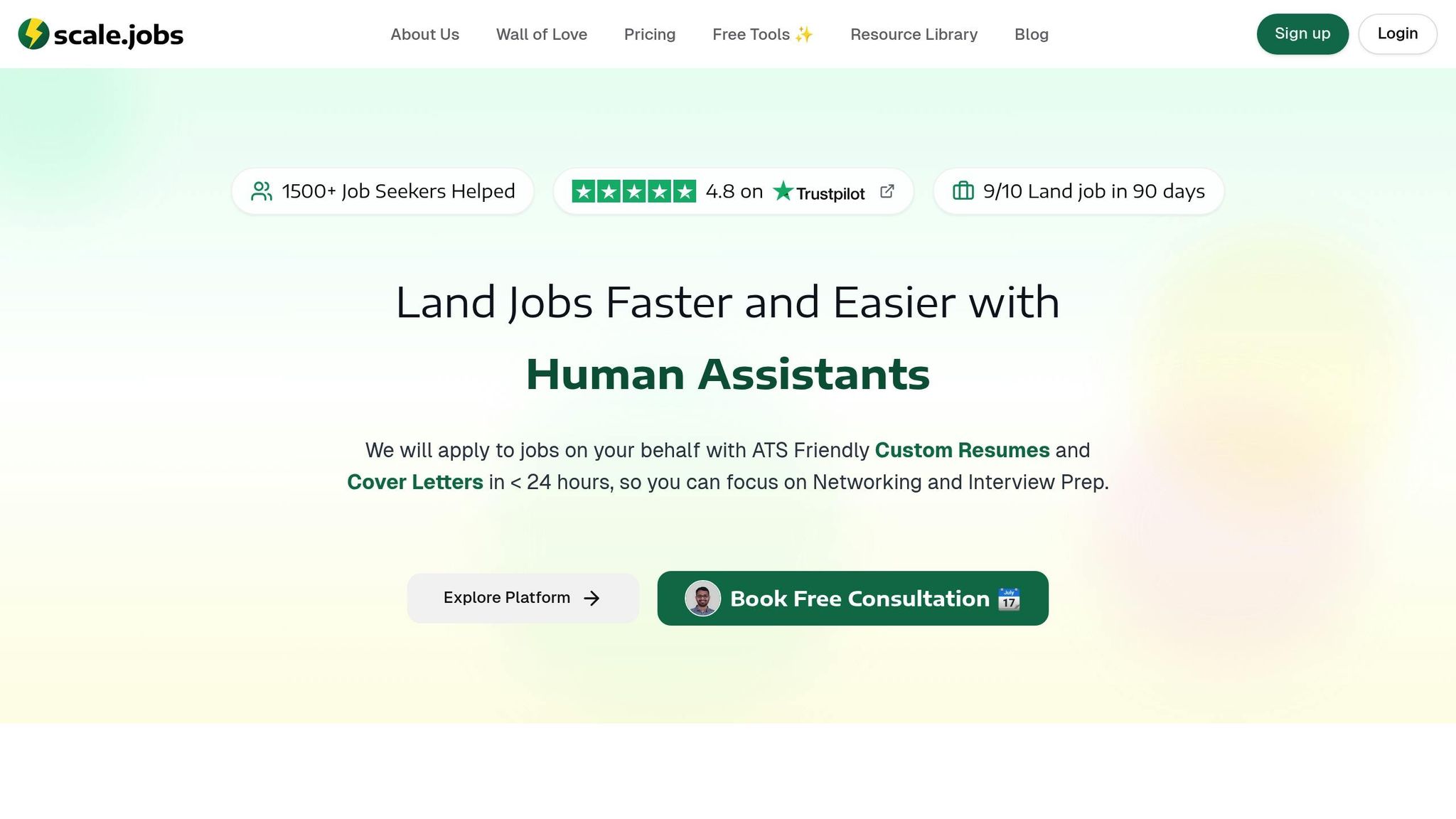
scale.jobs goes beyond basic tools by blending automation with human expertise. This dual approach ensures your resume is both ATS-friendly and appealing to recruiters.
The platform includes a free ATS Resume Checker, which provides detailed feedback on how well your resume aligns with ATS requirements and highlights areas for improvement.
For more tailored resumes, the AI Assistant Pro feature generates job-specific resumes, incorporating the right keywords while maintaining a natural and professional tone.
What sets scale.jobs apart is its Human Assistant service. Trained virtual assistants and reverse recruiters handle the entire application process for you. They optimize your resume for ATS, craft compelling cover letters, and ensure your materials resonate with hiring managers. With real-time updates and detailed work logs, you can track every step of the process. Plus, their flat-fee pricing (starting at $199 for 250 applications) eliminates recurring costs while ensuring your applications meet ATS standards.
For international job seekers dealing with visa requirements like H1B, F1, or TN status, scale.jobs’ human assistants are skilled at highlighting qualifications and legal work authorization in a format that works for ATS. This specialized approach can be a game-changer for candidates navigating complex hiring processes.
scale.jobs vs Competitors: ATS Optimization Comparison
Choosing the right ATS optimization platform can significantly impact your job search success. While many platforms share similar basic features, their pricing, support, and overall approach can vary widely. Here's how scale.jobs stacks up against its competitors, showcasing clear advantages.
Jobscan vs scale.jobs: Why scale.jobs Comes Out Ahead
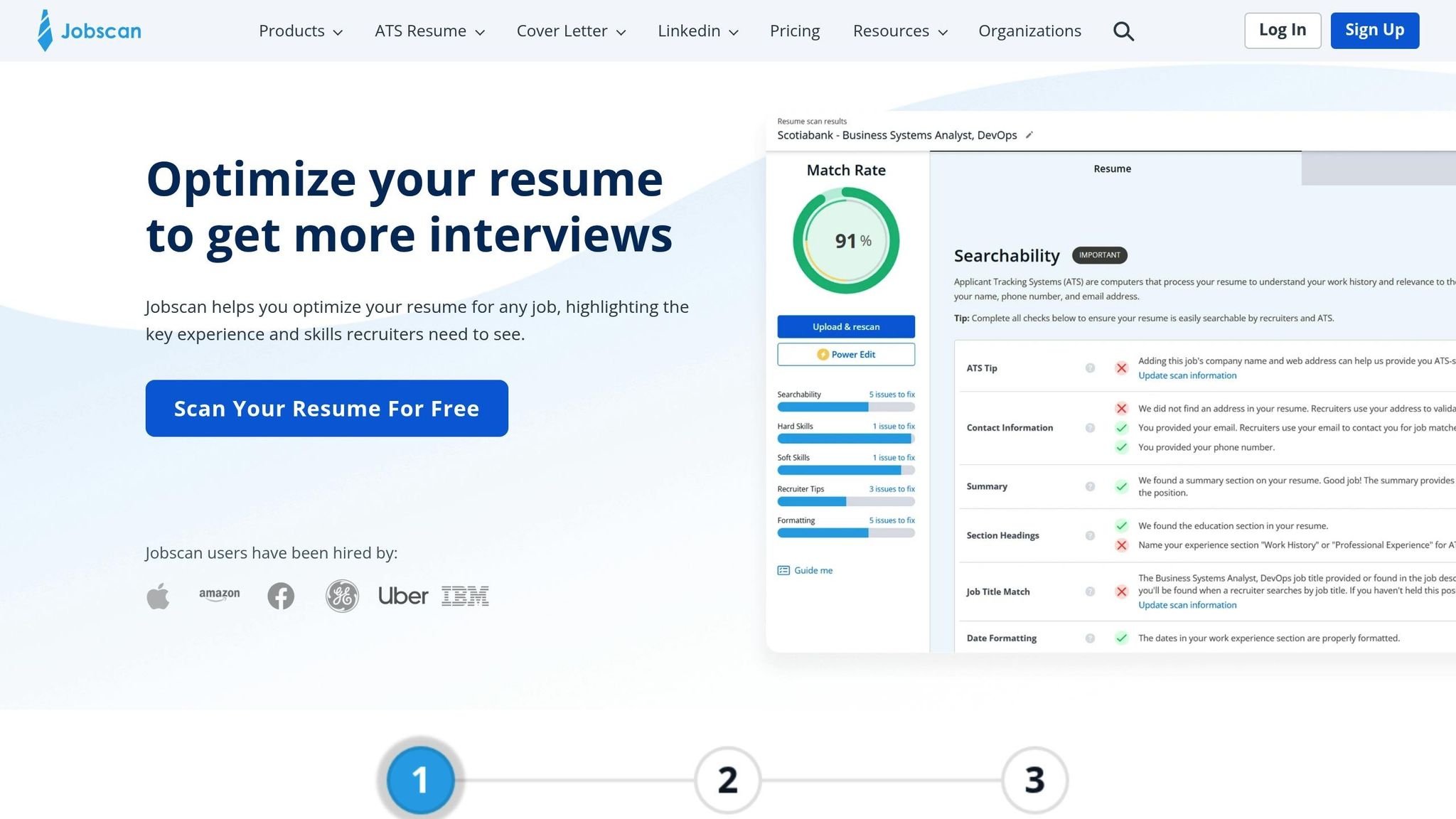
Jobscan is known for its keyword matching tool, priced at $49.95 per month. While it identifies keyword gaps in resumes, users must manually make the changes themselves.
In contrast, scale.jobs offers a more comprehensive solution. Its free ATS Resume Checker provides actionable feedback, going beyond simple keyword matching. For just $9 per month (during the launch period), the AI Assistant Pro generates tailored resumes, making it far more affordable than Jobscan.
But the real game-changer? The Human Assistant service. Unlike Jobscan, scale.jobs employs trained virtual assistants who handle the entire application process. These assistants manually review and optimize resumes for specific job postings, catching subtle details that automated tools might miss - an essential feature for complex roles or industry-specific requirements.
| Feature | scale.jobs | Jobscan |
|---|---|---|
| Free ATS Resume Checker | Yes | Limited scans only |
| Pricing | $9 (AI Pro) / Flat-fee available | $49.95/month |
| Human review option | Yes | No |
| Real-time updates | WhatsApp notifications | Email only |
| Proof of work | Screenshots provided | None |
For jobseekers juggling multiple applications, scale.jobs' flat-fee Human Assistant packages eliminate recurring subscription costs while providing hands-on support throughout the job hunt.
TealHQ vs scale.jobs: Transparency and Cost
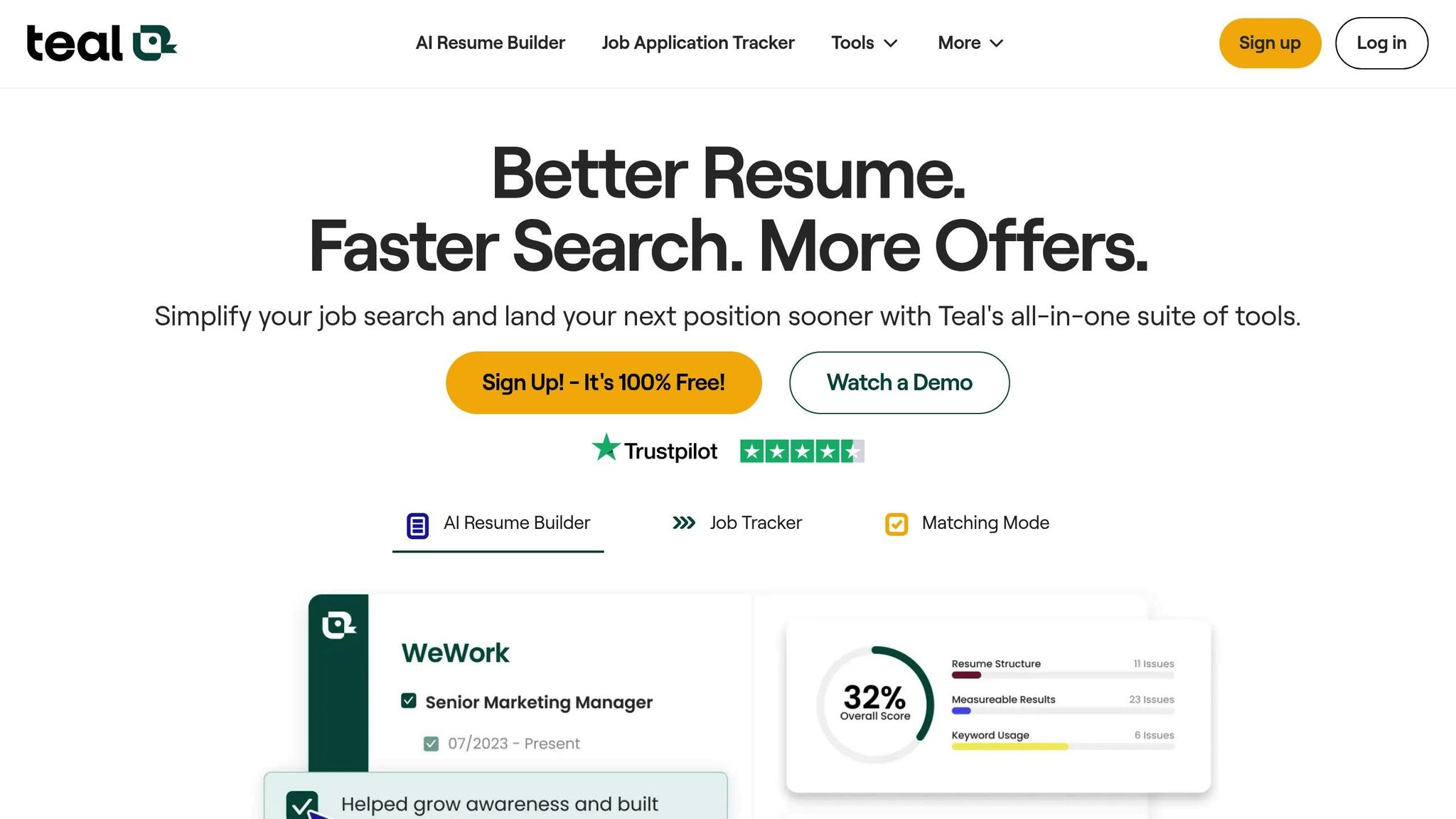
TealHQ offers job tracking and resume optimization for $49 per month or $9 per week. While their dashboard helps organize applications, it lacks the transparency and accountability many jobseekers need.
scale.jobs addresses these gaps with features like real-time WhatsApp updates, time-stamped proof-of-work screenshots, and detailed application logs. These tools provide jobseekers with full visibility into the application process, ensuring they know exactly what’s being done and when.
The pricing structure is another major difference. TealHQ relies on ongoing subscriptions, while scale.jobs offers a flat-fee model starting at $199 for 250 applications. This one-time payment option is particularly appealing for recent graduates or professionals managing tight budgets during extended job searches.
| Feature | scale.jobs | TealHQ |
|---|---|---|
| Pricing | $9 (AI Pro) / Flat-fee available | $49/month |
| WhatsApp updates | Yes | No |
| Proof-of-work screenshots | Yes | No |
| Unused credit refunds | Yes | No |
While TealHQ's platform is helpful for self-starters, scale.jobs' human-powered transparency ensures accountability and peace of mind, especially for those seeking a more hands-on approach.
Rezi vs scale.jobs: Human+AI vs AI-Only
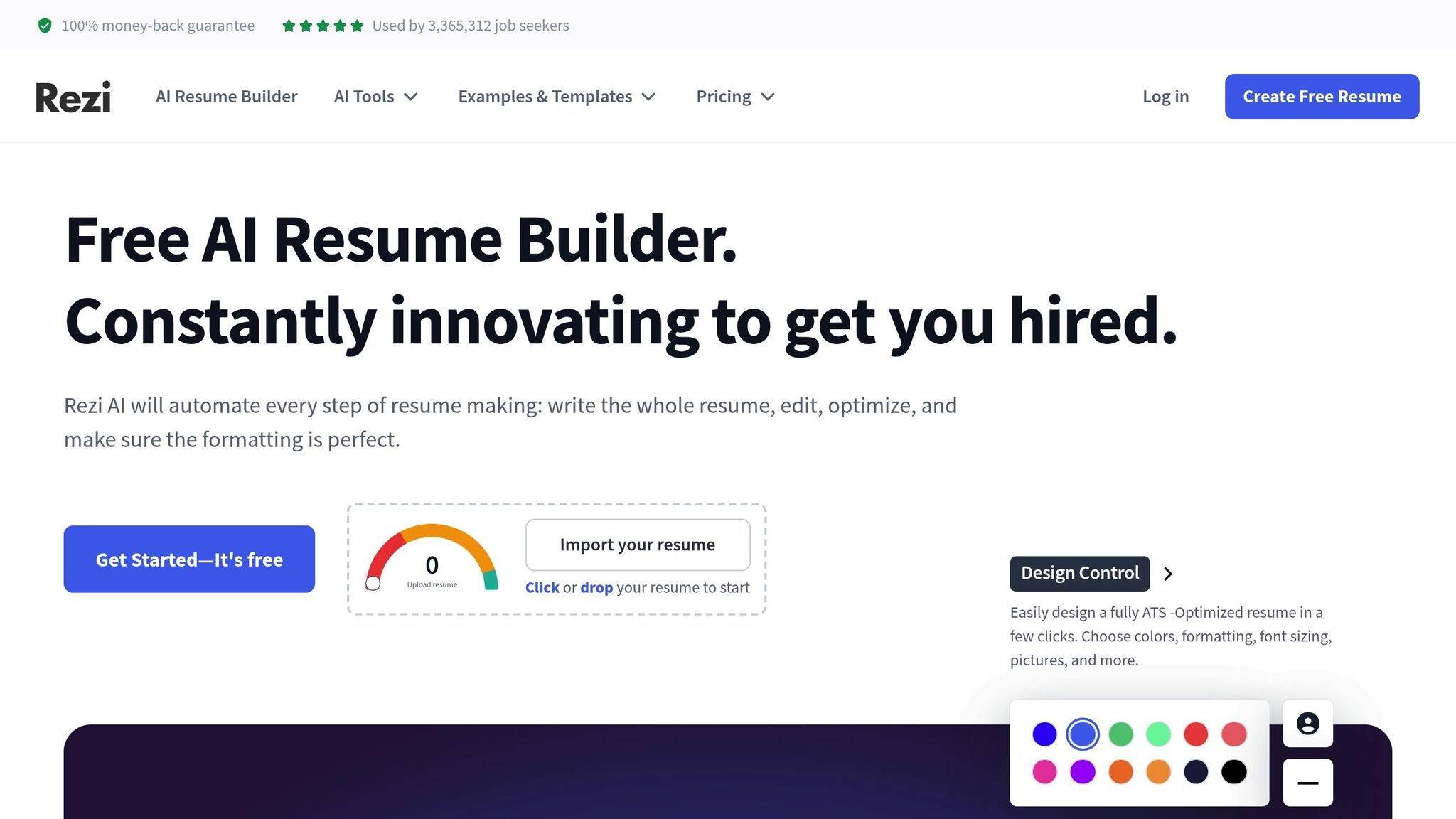
Rezi relies entirely on AI for resume building, charging $29 per month for its services. While its algorithm works well for straightforward applications, it struggles with more complex scenarios, such as addressing employment gaps, navigating visa requirements, or highlighting leadership experience.
This is where scale.jobs' hybrid Human+AI approach shines. The AI Assistant Pro efficiently handles routine optimizations, while human virtual assistants provide expert guidance for nuanced applications. This combination ensures that resumes are both ATS-friendly and appealing to hiring managers - an essential balance for competitive roles.
Transparency is another area where scale.jobs outperforms Rezi. With scale.jobs, you receive detailed proof-of-work documentation, including screenshots and updates, so you can see exactly how each application was customized and submitted. Rezi doesn’t offer this level of visibility.
| Feature | scale.jobs | Rezi |
|---|---|---|
| AI resume optimization | Yes | Yes |
| Human review option | Yes | No |
| Pricing | Flat-fee available | Subscription only |
| Transparency features | Screenshots, updates | None |
| Visa/immigration support | Human-guided | AI-only |
For straightforward applications, Rezi’s AI may suffice. But for jobseekers dealing with more complex situations, scale.jobs’ human oversight adds depth and precision, making it the better choice.
With its mix of free tools, affordable AI assistance, and optional human expertise, scale.jobs effectively addresses the 75% of resumes that typically get filtered out by ATS systems before reaching human eyes. This multi-layered approach ensures both technical compliance and strategic appeal, giving jobseekers a real edge in their search.
Getting Results with ATS Optimization
Understanding how ATS scoring works is just the beginning. To truly stand out, you need to optimize your resume so it not only passes through automated filters but also ends up in front of hiring managers. With so many resumes getting filtered out before a human ever sees them, mastering ATS optimization can be the difference between landing an interview and being overlooked. This section builds on earlier points about ATS parsing and keyword matching.
Key Takeaways
Successful job seekers blend technology with a human touch. While ATS algorithms prioritize things like keyword relevance, formatting, and context, they often miss the subtleties that a human reviewer would catch. A hybrid approach ensures your resume is both ATS-friendly and appealing to hiring managers.
Transparency in the application process is becoming increasingly important. Many job seekers submit dozens of applications without knowing if their resumes were properly processed by ATS systems or even received by employers. Tools that provide application tracking and proof-of-submission can help eliminate this uncertainty, giving job seekers peace of mind.
Cost is another factor to consider. Many traditional ATS optimization tools rely on monthly subscription models, which can become expensive during a prolonged job search. Flat-fee models, on the other hand, offer more predictable pricing and reduce the pressure to rush through applications. These considerations are crucial when selecting the right ATS tool for your needs.
Choosing the Right ATS Tools
When selecting an ATS tool, it’s important to find one that integrates seamlessly into your job search process. An ideal platform should cater to your specific needs and comfort level with technology.
Take scale.jobs, for example. It combines a free ATS-compliant resume builder, competitive AI-driven optimizations, and a Human Assistant service - all under a straightforward flat-fee model. What sets it apart is the Human Assistant service. This feature bridges the gap between automation and human judgment. Trained virtual assistants manually review applications, catching details that algorithms might miss, such as career transitions, employment gaps, or visa-related nuances.
Another standout feature is the platform’s real-time transparency. Through WhatsApp updates and time-stamped screenshots, job seekers receive visual proof of submission for every application. This level of accountability is invaluable when juggling multiple applications across different ATS platforms, each with its own quirks.
For those applying to a high number of positions, the flat-fee option provides consistent pricing and dedicated support. Plus, the unused credit refund policy adds financial flexibility - something subscription-based tools often lack.
FAQs
How can I make my resume ATS-friendly without overusing keywords?
To ensure your resume is ATS-friendly without overloading it with keywords, focus on naturally weaving relevant terms from the job description into your work experience, skills, and summary sections. Avoid stuffing or excessively repeating keywords, as that can make your resume seem forced and less appealing to read.
Instead, use keywords in context by linking them to specific achievements or tasks. For instance, if the job description highlights "project management", describe a time when you successfully led a project or managed a team. This method not only helps your resume get through ATS filters but also makes it more compelling for recruiters reviewing it.
For a streamlined way to optimize your resume, tools like scale.jobs provide features such as an ATS-compliant resume builder and actionable suggestions to better align your resume with job postings. These tools take the guesswork out of creating a professional, ATS-friendly resume.
What are the most common resume formatting mistakes that can confuse ATS systems?
Many applicant tracking systems (ATS) have trouble processing resumes with intricate formatting. Here are common pitfalls to avoid:
- Incorporating tables, text boxes, images, or columns
- Using inconsistent date formats (like mixing "MM/YYYY" with "Month Year")
- Adding elaborate designs, custom symbols, or unusual fonts
- Placing critical information in headers or footers
To make your resume ATS-friendly, stick to a clean, straightforward layout, opt for standard fonts, and use relevant keywords from the job description. Clarity is key - steer clear of design elements that could confuse the system. If you’re looking for an easier way to ensure compliance, tools like scale.jobs can help you craft resumes that work seamlessly with ATS platforms.
How does scale.jobs' human assistant service help my resume pass ATS filters better than AI-only tools?
Scale.jobs' human assistant service boosts your resume's chances of passing ATS filters by combining expert human insight with ATS-focused adjustments. Instead of relying solely on AI algorithms to match keywords, Scale.jobs employs trained virtual assistants and reverse recruiters who carefully customize your resume to meet specific job requirements and align with ATS ranking systems. They focus on proper formatting, strategic keyword placement, and overall structure to ensure your resume is ATS-friendly.
This human-first approach does more than automation can - it provides personalized attention, real-time updates, and precise tweaks that AI tools often overlook. With Scale.jobs, your resume isn’t just optimized for keywords; it’s thoughtfully crafted to grab attention, giving you an edge in today’s competitive job market.


![[UPDATED-2026] Job Search Strategies That Actually Work: Tips + Best Tools](/content/images/size/w600/2025/12/image-1764688576191.jpeg)

